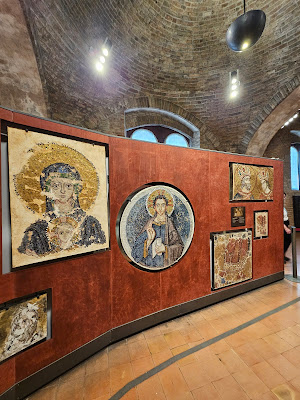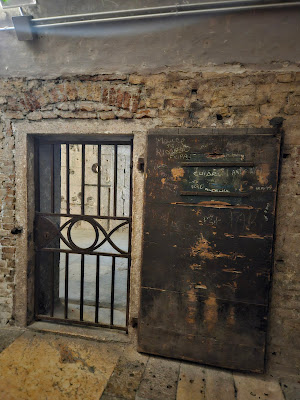Day 16 (19 May 2025)
This was our last day in
Venice and we'd planned to take it easy. We had entry tickets to St Mark's Basilica and Doge's Palace, both of which are in the famous Piazza San Marco. This is the iconic square which used to be inundated by pigeons (now it's seagulls). Unfortunately the square isn't very pretty
now as there's a lot of restoration going on. Many areas are under
scaffolding.
A little history: Venice
was a republic for 11 centuries, headed by the elected Head of State, the Doge, which is amazing. They had a democracy before modern day democracies! Unlike other countries in the region where power was in the hands of lords and wealthy families (like the Medicis in Florence), they emphasised cooperation and equal opportunity. It was a major trading centre with a strong maritime presence until it was conquered by Napolean in 1797 and became part of Italy in 1866.
When Napolean conquered Venice, he declared it "Europe's most beautiful living room" and built a giant palace in the square. Venice has been facing a serious problem of rising sea levels, made worse by human activities which cause the city to sink. climate change. Efforts have been made to build a dam system but it has been plagued by delays and corruption. Storm surges have become more frequent due to climate change and you probably have seen photos and videos of St Mark's Square entirely flooded, and people walking on planks. The last major flood was in 2019 where more than 80% of the city was underwater (the water came up to thigh level!) According to our guide, no apartments are allowed on the ground floor, only shops, because of flooding risks.
This bell tower is St Mark's Campanile. It served as a watch tower for ships and doubles up as a lighthouse. The statue at
the top is covered in gold, and reflects sunlight so even in the early
morning or day time, it can guide ships.
This is the St Mark's clock tower. If you walk beneath the archway, the street leads to Rialto.
Because it uses Roman numerals and looked like an old design feature, I did not realise that it was a working clock until the numbers moved! (It only changes every 5 minutes though).
First, we visited Basilica di San Marco (St Mark's Basilica) built in the Byzantine era. Because of the spice trade, much of Venetian architecture has Eastern. Hence, the cathedral looks Persian or Turkish, unlike other cathedrals in Italy.
The decor within the basilica uses a lot of gold and mosaic art.
Even the floor has beautiful mosaic art, some dating back to medieval times.
There are also old tapestries and books.
The patron saint of Venice is St Mark (hence the name of the basilica), whose emblem is the winged lion. You see this on flags that are flown more than the Italian flag because Venetians were their own
republic for so long they see themselves as Venetians first. On the main facade of the basilica are four bronze horses that were war spoils from the crusades and rare Classical antiquity statues. However, the four horses have now been brought into the basilica for preservation. The ones on the balcony seen here are replicas.
A great bird's eye view from the balcony.
Next, we paid a visit to the Doge's Palace next door, which has been converted into a museum. Since we did not research this before our visit, we didn't know what to expect. (And to be honest, we weren't expecting much 😆). So imagine our astonishment when we were greeted by an onslaught of art. The Doge's Palace was the seat of government so there's a massive number of rooms, like offices, the Doge's personal apartment, Senate Chamber, council chambers, state chambers, etc. And there was art everywhere. On the walls, on the ceilings. By great Renaissance Venetian artists including Titian, Tintoretto and Veronese. Here's a list of some of the most important artworks in the palace.
And then we walked into the Great Council Chamber and found ourselves face-to-face with Tintoretto's Il Paradiso. It's a massive oil painting at 22 metres long (the longest canvas painting in the world) depicting paradise with about 500 saints and angels and Jesus and Mary at the top.
In 1577, a
great fire destroyed many rooms in the Doge's Palace, including a beloved 14th C Paradise fresco painting on the Chamber of the
Great Council's east wall. A committee
organised a competition to restore the lost "Paradise". All the leading Venetian artists took part
including Tintoretto. He didn't win because his version was deemed too
intense. The job was awarded to Veronese and Bassano. However, Veronese died before the work could get off the ground, and Tintoretto, eager to get this commission, agreed to make some changes to his draft. He got it and as they say, the rest is history.
Intense is the word. My photos don't do this painting justice. Even Michelangelo's David did not stop me in my tracks like Il Paradiso did. It's not about the size. There's something about this painting that grabs you by the jugular. Maybe it's Tintoretto's masterful use of colour and contrast that creates so much drama. I learned a new word - chiaroscuro (an Italian term that refers to the extreme contrast of light and dark in a painting). It exudes raw emotion. Art critic and historian John Ruskin declared it "the most beautiful in the history of art". Even Andre, who is not an art person, said, "I'm having an existential crisis. I wah until I cannot wah any more." He described it as a sensory overload which is pretty accurate.
The palace also contained a prison and to get to it, prisoners had to cross the
Bridge of Sighs, so named as as it was the last time they would experience freedom. This is what the bridge looks like from outside.
View of the Grand Canal from the palace.
Outside, the Doge's Palace is a beautiful courtyard.
A grand ceremonial staircase was built with, flanked by the statues of Mars and Neptune which represented Venice's might both on land and sea.
There's also a display of the Doge's gondola. Venice had a major shipmaking industry and boats were the Rolls Royces of old Venetian elite. Like their architecture, the design of Venetian boats showed traces of Eastern influence thanks to all the global trade. The long and thin design had the added benefit of being able to navigate Venice's narrow canals.
After that, we explored the South bank of the Grand Canal. Once again, it feels like every corner we turn is a picture-perfect scene.
It's less crowded here and it feels like a more arty area. We passed by an art shop which sold pigment! Such a pretty window display.
We chanced upon the Church of San Salvador and it turned out to be the home of Scuola Grande, the most prestigious concert hall in Venice! I got really excited when I found out there was going to be a concert featuring
Vivaldi tonight. So was tempted to attend (listening to Vivaldi, a Venetian, in
Venice, is pretty special!) but the repertoire was not something familiar to me. (They were going to playing Four Seasons only tomorrow night, sadly). In the end, we gave it a miss.
Then we came to the Santa Maria della Salute basilica which is so gorgeous and just steps from the waterfront.
Finally, dinner. We happened to come across Noemi Ristorante which had great reviews and a special set meal promotion - a 2-course meal with water and coffee for E25
(cheap for Italy). It was one of my favourite meals in Italy. The pastas especially were delicious, so were the macchiatos. The seabass came as a surprise though. I'm not used to my fish being served unboned and unscaled!
I know I've already said "finally" but how can we leave out gelato? Venchi is a high end chain known for gelato and chocolates that has gone global (it has come to Singapore at Jewel!) We tried it and it's pretty good. Well worth the hype.
I ❤️ Venice so much. It has so much charm. It's one of those places that will linger on in my memories. One of the items on my bucket list is to go on an overseas painting trip. If that ever happens, Venice would be on the list.
Some parting photos of my favourite Italian city.






















































No comments:
Post a Comment